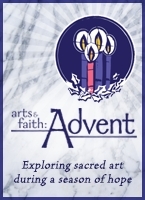Arts & Faith: Week 1 of Advent, Cycle B
William Holman Hunt, “The Light of the World,” 1851

At the start of Advent, the Gospel calls us to vigilance—to watch and be ready for the Lord of the house, awaiting his return. William Holman Hunt’s The Light of the World offers us one image of what this arrival might look like. The Light of the World is deeply symbolic, showing Christ arriving at a door at night. It’s an allegory for Christ seeking entry at the door of the human heart. His way to the door is lit by a lantern, casting a soft light on the door to show that it is overgrown with plants; it has not been opened in a while. The plants also show that it is not only a late hour, but late in the year—they are dry, past harvest, and ready to crumble away as winter comes.
Hunt’s image softens any apprehension about the coming of the Lord, as he presents, through the choice of colors and in the representation itself, a warmth and gentleness that shows Christ’s deep love for us as the reason for his coming. A crowned and robed stately sovereign, Christ the King ventures into the darkness and the mess of brambles to seek entry into our hearts. This majestic King whose arrival would be expected to be announced by fanfare instead taps gently at the door to request entry. Our humble King seeks encounter instead of fanfare, our conversion instead of our confinement to darkness.
One of the boldest symbols of the image is the lantern Christ holds in his left hand, which shows Christ as the One that disperses the dark and illuminates the dead places within our hearts. A subtle detail is the fruit on the ground—a symbol of Original Sin, of our fall into the darkness of deception. Yet Christ does not leave us out in the darkness but comes for us, as our Light, into the dead of night.
Finally, a significant detail of the door is its lack of a handle or knob. This is Hunt’s way of showing that the door can only be opened from the inside, through our faithful response to Christ’s steadfast invitation. Watching and waiting for his coming calls us to attentiveness to encountering the Lord above all, even as this busy and frantic season gets underway.

Commentary is by Daniella Zsupan-Jerome, director of ministerial formation at Saint John's University School of Theology and Seminary.
Related Ignatian reflection on this week’s art
William Holman Hunt’s painting

Lighting the Advent Wreath (Ages 6–9)
Instruct children to draw an Advent wreath on a sheet of paper, and then have them cut out three strips of purple construction paper and one strip of pink—these will be the candles. Have children glue the four candles to the wreath drawing. Have children cut four flames out of yellow and orange construction paper and paper clip the flames to the wreath drawing. After discussing William Holman Hunt’s painting and its meaning, have children “light” a purple candle by gluing or taping the flame to the candle. Say: During Advent, we light the Advent wreath to prepare the way for the Light of the World, Jesus Christ. Let us pray to the Lord to guide us in our prayers and lives during Advent. During each week of Advent, “light” the other candles and pray silently.
Opening Our Own Doors (Ages 12–15)
In William Holman Hunt’s painting, we see that the door does not have a doorknob or handle, which means it can only be opened from the inside. Have young people think about the people or things in their lives that they have closed the door on or are scared to open. Give examples, such as being scared to stand up to a friend or not opening the door to a new challenge. Allow young people a few minutes for reflection and invite young people to journal their thoughts. After a few moments, lead the group in a prayer: Dear Jesus, you are welcome in our lives, but sometimes it is hard to open the door. Please give us strength to be open and welcoming, to see beyond the darkness, and to let the light into our own lives.

